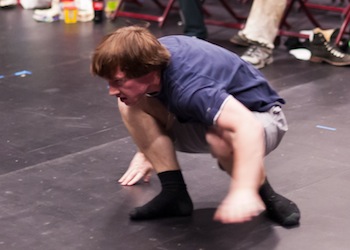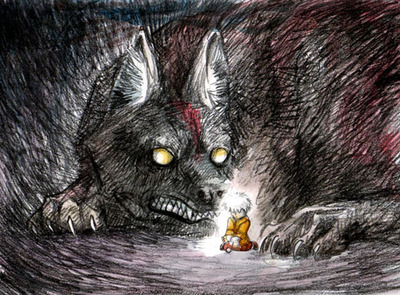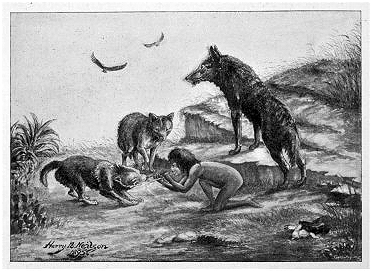
The following post is an informal analysis of the character Wild One in the play Raising Cane: A Family Portrait by Stephen Cedars, as it relates to my specific interpretation of the character. It is also to disprove that the character in question is a "wild child", that term referring to a child that is raised from a very young age with little to no human contact and is then assimilated into the society of a species of animal. While the character does exhibit qualities similar to that of a wild child, the character has not actually had any interactions with animals outside of food, and certainly had no interactions that meet the previously stated qualifications. The following is all of the information on the character from the play that I felt were relevant to character development.
"A young feral creep depraved and ruined, uncontrollable."
"Unseen but mentioned.... a chamber wherein is kept bound the Wild One."
"...Another figure is propelled on. This is the WILD ONE. He growls. Even in the low light, his movement reflects his feral nature. He launches at Lucy, scratches and bites at her. They struggle. In his attack an air of childish playfulness, a viciousness not necessarily driven by hatred or violence."
"... Fend off his unfocused but intense attacks, crying to herself. He takes the broom, SNAPS IT IN HALF. He forces her to the ground, growls, drops, and BITES INTO HER LEG."
"...I know well that you let out the wild one too-"
(Page 16)
"I'd come out and take on the wild one.... thinkin' maybe I'd give her giggles, she'd let me off...."
(Page 24)
"You tell her let the wild one alone and still you say not a damn thing when she lets him out what to rip into me leg..."
"She won't want me seeing her lettin' the wild one run free as tis, so...well, just get on."
(Page 25)
"Pathetic excuse for a dada, I'll tell ya."
"I's ignoring it, but... you let him out, Fannie. It's all I done ever asked you, to let him be, and still you let him out."
"All I ever asked! I done so much for ye...And still you done it, over and over, well, no more! You set him loose, that poor wild boy, even last night! My boy! The only one I done gave a shit about - the one who ain't got nobody could give a shit about him, wild as he is. You let him out - and as I now know, you do it not to hurt me, not to do punishment to me, as I thought it was, but just so he can hurt others!
(page 33)
"WILD BOY (starts to cry) Dada!"
(Page 36)
"He reaches for the wild boy, who bites at his fingers."
"She looks at wild boy, holds out her hand. He takes it."
(Page 37)
Now, the first is a list of qualities exhibited in "wild" children, with the research referenced at the end of this article.
Qualities Exhibited in Wild Children:
Tolerance for heat and cold
Appetite for raw meat
Even-all-fours locomotion
Defectiveness of intelligence
Absence of speech
Calluses on knees and palms
Licked all liquids
Ate in crouched positions
Panted like wolves, tongues out
Move fast
Never slept after midnight, howled and prowled at night
If approached, made faces and bared teeth
Acute hearing and smell
Bad sight during the day
Skills developed after a minimum of 5 years of human assimilation by wild children:
Recollection of names of babies around house
Concept of color
Food only from their plate and recognition of their cup
Clear 30 words, see object and name it
Never in a spontaneous way
We see in these case studies and the script, that (in agreement with the critical period hypothesis) the amount of time that would have needed to be spent with Wild One in order for him to have skills, such as speech and recognition and identification, was not spent. Additionally, the adaptation of animal-like qualities does not coincide with the environment that Wild One was brought up in. This entails an isolated chamber with little to no human interaction. Even if the character were to somehow imitate animals, which he has never seen, there is also the sudden change in the relationship between him and Lucy at the end of the play, which is for the most part ignored.
My diagnosis, based again on more case studies and my own personal intuition as an actor (and is no way official) would be severe depressive disorder with psychotic features, manifesting as clinical lycanthropy. This maintains most of the qualities that would have been exhibited if he were a "wild child" but also allows him the ability to return to a human state of mind if his specific case involved a psychological "trigger" which could put the character into one of his episodes. The trigger in this case would be the Queen, since it is with her death that Wild One begins to exhibit more normal behavior and grows fond of Lucy. The study "Lycanthropy Alive in Babylon" supports this diagnosis since patients 1,2,3,4, and 6 had a similar condition. This diagnosis helps provide back-story for this character as well since all of the patients in the Babylon trial had some life-threatening event with a theme of loss or separation with aggression. The trials also give an animal for the Wild One to imitate, since 6 of the 8 cases involved the patients imitating dogs and one involved the imitation of a wolf.
Also, as a side note, the case report "Belief in transforming another person into a wolf: could it be a variant of lycanthropy?" is the study of a man diagnosed with depressive disorder and psychotic features manifesting as clinical lycanthropy. If you read, you will see that he interestingly had a history of an incestuous relationship, which is one of the prominent themes in the play.
Finally, if this diagnosis were to be accepted by the playwright, then the character is not completely "ruined" as the character description states. A healthy dose of risperidome should suppress the symptoms.

Wild One (Thomas Beheler)
References (find them if you can):
"Mowgli in Real Life in News from India: Details of the Remarkable Story of Wolf Girls revealed in the Jungle in West Bengal", NYT, 12/26/26 Social News sec. pg 4
Wolf Child and Human Child by Gesell Oliver, J. "Deur wolwe grootgemaak," Huisgenoot 3/7/85 (26-27) Singh and ingg, Feral Children and Clever Animals
Belief in transforming another person into a wolf: could it be a variant of lycanthropy?
Lycanthropy as a culture-bound syndrome: A case report and review of the literature.
Lycanthropy alive in Babylon: the existence of archetype



